How Hurricane Milton compares to the ‘Great Galveston’ – America’s deadliest storm that killed 8,000 in 1900
Hurricane Milton is on track to become one of the most powerful and destructive storms since 1900.
When the Category 4 Hurricane “Great Galveston” hit, that’s what happened the entire island city of Galveston decimated, Texas, killing 8,000 of its approximately 40,000 residents.
The 15-foot storm surge inundated the island and destroyed another 3,600 buildings, the equivalent of roughly $26 billion in today’s currency.
Forecasters predict Milton — also a Category 4 — could bring a record-breaking storm surge of 15 feet to Tampa Bay.
While Hurricane Milton bears some similarity to the 1900 Great Galveston hurricane — the deadliest in U.S. history — it won’t cause the same destruction, experts say.
Fortunately, today there are much more advanced warning systems and emergency plans, and modern buildings are generally built to withstand tropical storms.
“Hurricane forecasting was in its infancy in the 1900s and took the city of Galveston by surprise,” Zierden says.
‘There were very few, if any, evacuations, and the structures and such were not built to current building codes and were much more vulnerable. So I don’t think we’ll ever see anything like that again,” he added.
Ahead of Milton, emergency storm warnings have been issued for 51 of Florida’s 67 counties and evacuations have been ordered for more than 1 million people in West Coast counties.
Both Milton and Hurricane Great Galveston are Category 4 storms that developed over the Gulf of Mexico and followed unusual west-to-east paths.
This kind of trajectory “is relatively rare, but it’s not impossible,” Florida climatologist David Zierden told DailyMail.com.
“What we see more often are hurricanes that develop in the northwest Caribbean or even come into the Gulf from the Atlantic Ocean, then warp again and hit the west coast of Florida, such as Hurricane Charlie in 2004, Hurricane Ian in 2022, Hurricane Wilma who struck. southwest Florida in 2005,” he added.
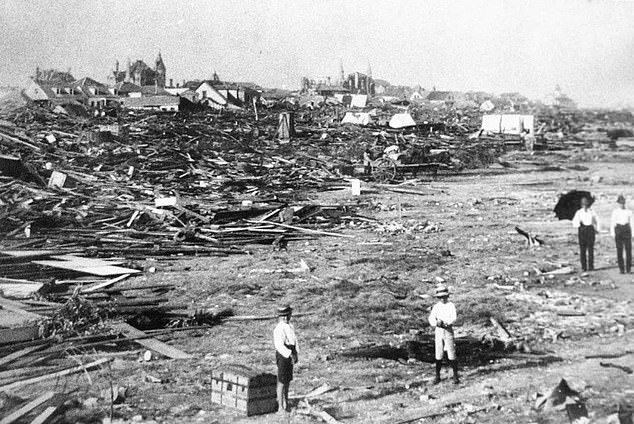
Hurricane Great Galveston destroyed the entire island city of Galveston, Texas on September 8, 1900
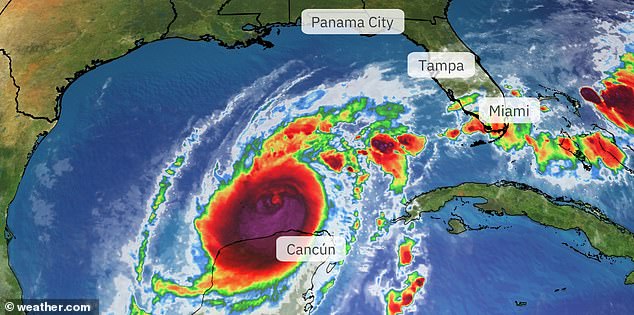
Florida is bracing for Hurricane Milton to make landfall on Wednesday as it barrels toward the coastline at 12 miles per hour
Before Hurricane Great Galveston struck, the city was well on its way to becoming a major American port and thriving commercial center.
But when the storm roared ashore, packing winds of 140 miles per hour and a storm surge of 15 feet, it caused such extreme destruction that it took Galveston 12 years to rebuild.
After making landfall in Texas, the Great Galveston Hurricane traveled into Oklahoma and Kansas, turning northeast and crossing the Great Lakes and into Canada.
However, Hurricane Milton immediately began moving eastward after forming over the Gulf, straight toward Florida.
This is all the more unusual, but not unheard of, according to Anthony Yanez, chief meteorologist for Houston’s local news station KPRC2.
Previous storms have followed this same track before, such as Hurricane Mitch in 1998 and Hurricane Emily in 2017. wrote.
Hurricane Mitch killed two people and caused $40 million in damage when it made landfall in Florida. There were no fatalities during Hurricane Emily, but damage in Louisiana and Florida totaled $10 million.
Hurricane Milton is currently in the Gulf of Mexico, 530 miles southwest of Tampa – where it is expected to hit with full force on Wednesday – and is moving from east to northeast.
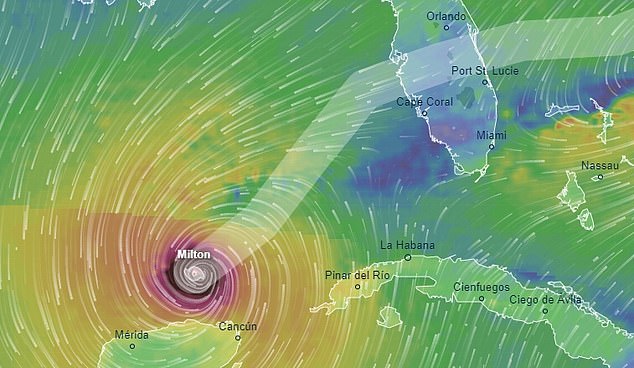
Trackers have closely followed Milton’s path as it headed toward Florida
In terms of damage, displacement and deaths, there is no indication that Hurricane Milton will be as devastating as Hurricane Great Galveston.
But Milton’s impact could still be extreme, especially if the eye of the storm passes just north of Tampa Bay, historical geographer and hurricane hazards expert Craig Colten told DailyMail.com.
If that happens, there could be truly massive storm surges from the Bay Area all the way to Tampa. St. Pete could also get significant water, a more direct surge,” he said.
‘It can be devastating. That could wash away bridges, disrupt water supply systems and disrupt all kinds of infrastructure,” he added.
In addition, Milton’s impact could be exacerbated by the devastation of Hurricane Helene, which devastated the southeastern U.S. just ten days before experts began issuing warnings about the storm.

More than 6,000 people died when a storm surge of 8 to 16 feet inundated the island, destroying more than half of the homes and buildings
Helene killed at least 225 people. Hundreds of victims are still missing.
“Unfortunately, some of the Helene victims are in the path of this storm,” Gov. Ron DeSantis said during a press conference on Monday.
“A lot of these homeowners are in recovery mode,” Zierden said.
“They probably didn’t have the time or resources to prepare for this as much as they normally would,” he added.
This could increase the damage from this approaching storm, especially as debris from Helene is swept up in the storm surge from Milton, Zierden said.
In areas of Florida affected by Helene, more than 40,000 cubic feet of debris was removed in less than two days, officials say.
But he hopes that with Helene’s memory still fresh, more people will take evacuation orders seriously, potentially reducing the overall number of injuries and deaths.
Milton rapidly intensified over the Gulf of Mexico on Monday, strengthening from a Category 1 hurricane to a near-record-breaking Category 5 hurricane with winds of 190 miles per hour.
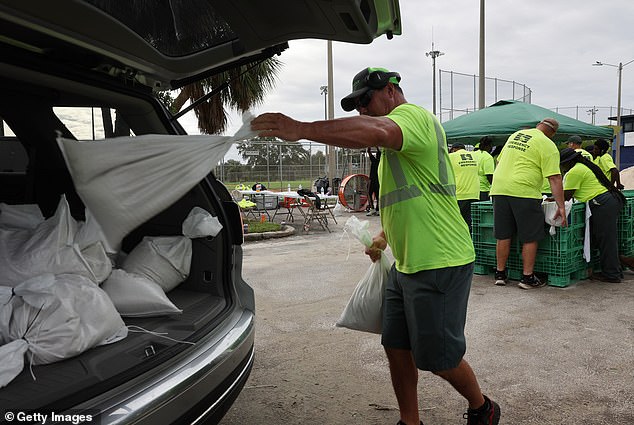
Floridians are still in “recovery mode” after Hurricane Helene
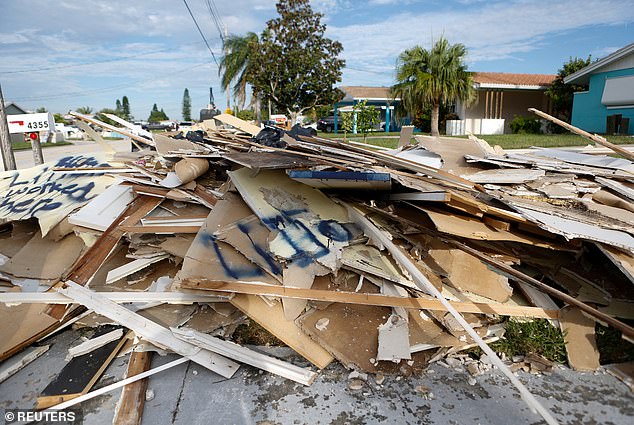
In areas of Florida affected by Helene, more than 40,000 cubic feet of debris was removed in less than two days, officials say.
The storm has now weakened to category 4, but is expected According to NHC, it will remain an “extremely dangerous hurricane” due to landfall along the west coast of Florida.
The NHC also said that the central pressure within Hurricane Milton has fallen to the second-lowest level on record in the Gulf of Mexico and the lowest in the Atlantic Basin since 2005.
The central pressure of a hurricane is closely related to its intensity. The lower the pressure, the more intense the storm and maximum sustained winds, according to the National Oceanic and Atmospheric Administration (NOAA).
And in terms of maximum sustained winds, Milton is the strongest hurricane in the Atlantic Basin since Hurricane Dorian in 2019, and ranks as the fourth-strongest storm on record.
A South Florida meteorologist recently became emotional while describing the severity of Hurricane Milton.
“It’s just an incredible, incredible, incredible hurricane,” said John Morales, a certified consulting meteorologist and hurricane specialist for NBC6 in Miami.
His voice broke as he described the storm’s rapid intensification, noting that the hurricane’s pressure dropped by 50 millibars in ten hours.
“I apologize,” he said, “but this is just terrible.”
But fortunately, unlike Hurricane Great Galveston, Florida residents won’t be blindsided by Milton.
Counties began issuing evacuations Monday, and “there is still plenty of time for warnings and for public awareness and to ensure that Floridians are prepared for a storm of this magnitude,” Zierden said.
Extreme storms like Milton may seem unprecedented, but as we enter a new climate reality, it may be time to “set that term aside,” Colten said.
“With a warmer climate, a storm like Helene or Milton is the new precedent,” he said.
